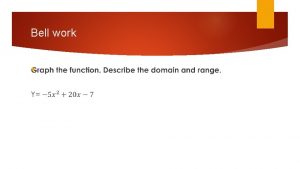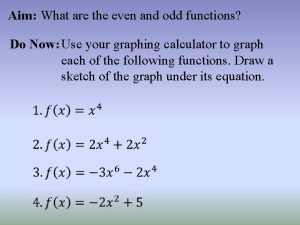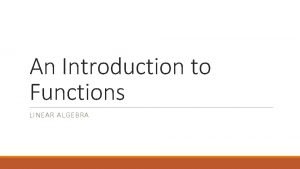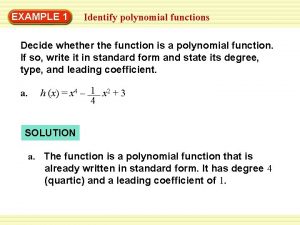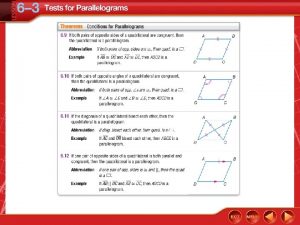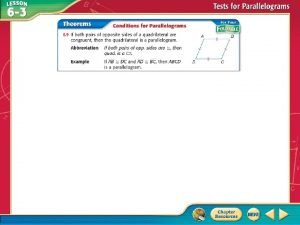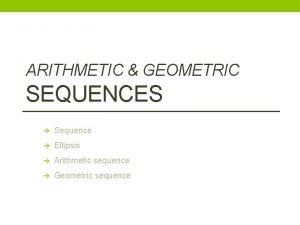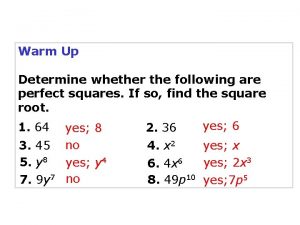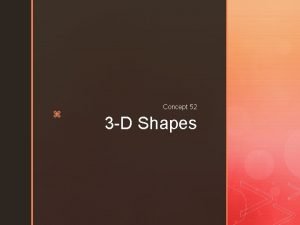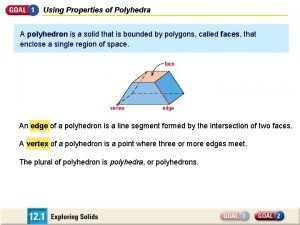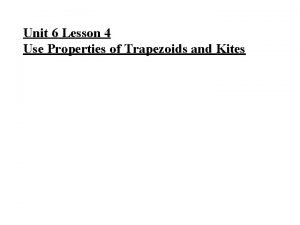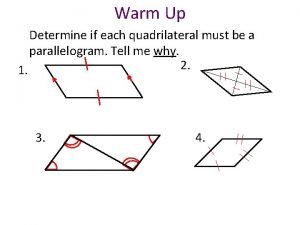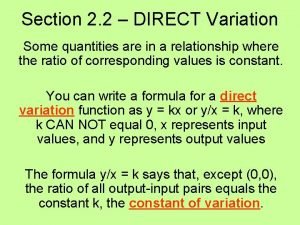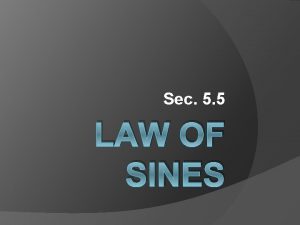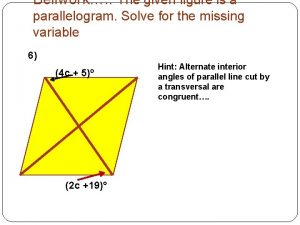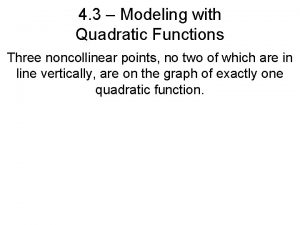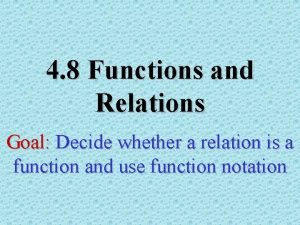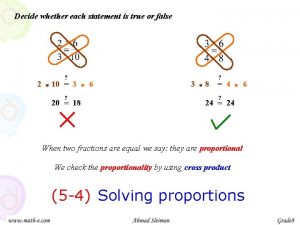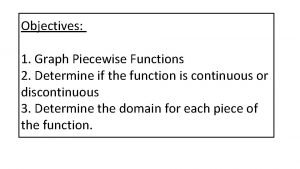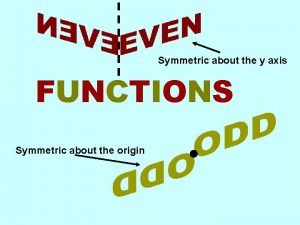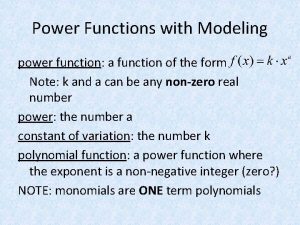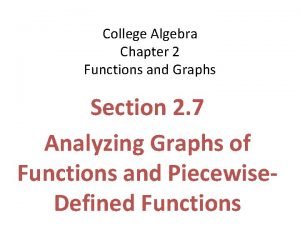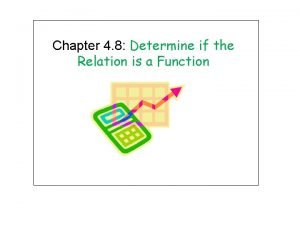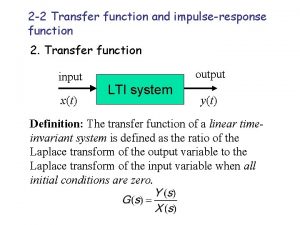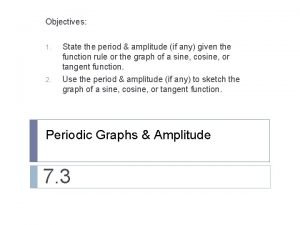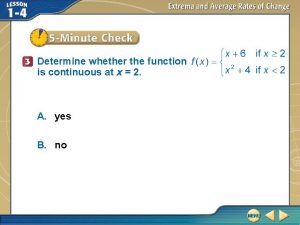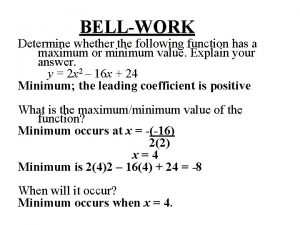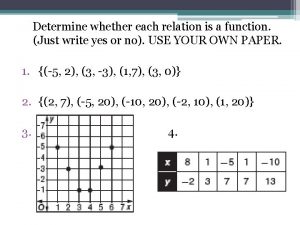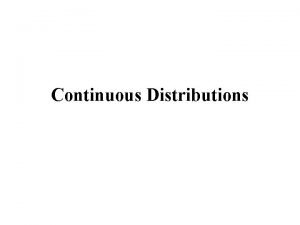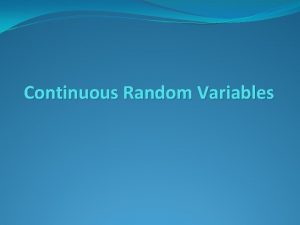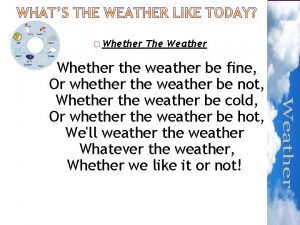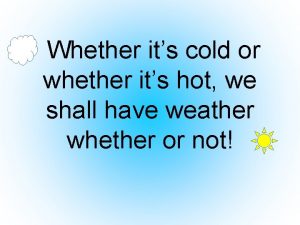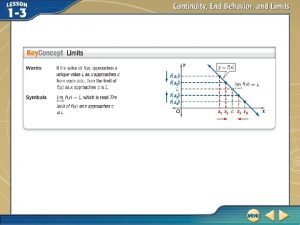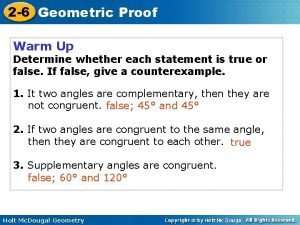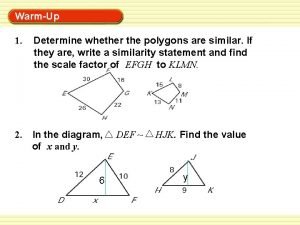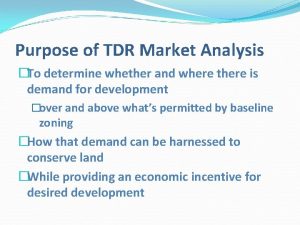Determine whether the function is continuous at x













































- Slides: 45


Determine whether the function is continuous at x = 2. A. yes B. no

You estimated limits to determine the continuity and end behavior of functions. (Lesson 1 -3) • Estimate limits of functions at fixed values. • Estimate limits of functions at infinity.

• one-sided limit • two-sided limit

Estimate a Limit = f (c) Estimate using a graph. Support your conjecture using a table of values. Analyze Graphically The graph of f (x) = 4 x + 1 suggests that as x gets closer to – 7, the corresponding function values get closer to – 27. Therefore, we can estimate that = – 27.

Estimate a Limit = f (c) Support Numerically Make a table of values for f, choosing x-values that approach – 7 by using some values slightly less than – 7 and some values slightly greater than – 7.

Estimate a Limit = f (c) The pattern of outputs suggests that as x gets close to – 7 from the left or right, f (x) gets closer to – 27. This supports our graphical analysis. Answer: – 27

Estimate using a graph. A. 3, C. – 1, B. 1, D. – 3,

Estimate a Limit ≠ f (c) Estimate using a graph. Support your conjecture using a table of values. Analyze Graphically The graph of suggests that as x gets closer to 4, the corresponding function value approaches 8. Therefore, we can estimate that is 8.

Estimate a Limit ≠ f (c) Support Numerically Make a table of values, choosing x-values that approach 4 from either side.

Estimate a Limit ≠ f (c) The pattern of outputs suggests that as x gets closer to 4, f (x) gets closer to 8. This supports our graphical analysis. Answer: 8

Estimate using a graph. A. 0, C. 6, B. 0, D. – 6,




Estimate One-Sided and Two-Sided Limits A. Estimate each one-sided or two-sided limit, if it exists. The graph of suggests that f (x) = – 2 and f (x) = 3. Because the left- and right-hand limits of f (x) as x approaches 1 are not the same, does not exist.

Estimate One-Sided and Two-Sided Limits Answer:

Estimate One-Sided and Two-Sided Limits B. Estimate each one-sided or two-sided limit, if it exists. 0 0 The graph of g(x) suggests that g(x) = – 1 and g(x) = – 1. Because the left- and right-hand limits of g(x) as x approaches 0 are the same, and is – 1. exists

Estimate One-Sided and Two-Sided Limits Answer:

Estimate each one-sided or two-sided limit, if it exists. A. B. C. D.

Limits and Unbounded Behavior A. Estimate , if it exists. Analyze Graphically The graph of and suggests that because as x gets closer to 2, the function values of the graph increase.

Limits and Unbounded Behavior Neither one-sided limit at x = 2 exists; therefore, we can conclude that does not exist. However, because both sides approach ∞, we describe the behavior of f(x) at 2 by writing Support Numerically .

Limits and Unbounded Behavior The pattern of outputs suggests that as x gets closer to 2 from the left and the right, f(x) grows without bound. This supports our graphical analysis. Answer: ∞

Limits and Unbounded Behavior B. Estimate , if it exists. Analyze Graphically The graph of and suggests that because as x gets closer to 0, the function values from the left decrease and the function values from the right increase.

Limits and Unbounded Behavior Neither one-sided limit at x = 0 exists; therefore, does not exist. In this case, we cannot describe the behavior of f(x) at 0 using a single expression because the unbounded behaviors from the left and right differ. Support Numerically

Limits and Unbounded Behavior The pattern of outputs suggests that as x gets closer to 0 from the left and the right, f(x) decreases and increases without bound, respectively. This supports our graphical analysis. Answer: does not exist

Use a graph to estimate , if it exists. A. ∞, C. ∞, B. –∞, D. –∞,

Limits and Oscillating Behavior Estimate , if it exists. The graph of f(x) = x sin x suggests that as x gets closer to 0, the corresponding function values get closer and closer to 0.

Limits and Oscillating Behavior Therefore, Answer: 0 .

Estimate A. does not exist B. 1 C. 0 D. – 1 , if it exists.



Estimate Limits at Infinity A. Estimate , if it exists. Analyze Graphically The graph of suggests that As x increases, f(x) gets closer to 1. .

Estimate Limits at Infinity Support Numerically The pattern of outputs suggests that as x increases, f(x) approaches 1. Answer: 1

Estimate Limits at Infinity B. Estimate , if it exists. Analyze Graphically The graph of suggests that = – 1. As x increases, f(x) gets closer to – 1.

Estimate Limits at Infinity Support Numerically The pattern of outputs suggests that as x increases, f(x) approaches – 1. Answer: – 1

Estimate Limits at Infinity C. Estimate , if it exists. Analyze Graphically The graph of f(x) = cos x suggests that does not exist. As x increases, f(x) oscillates between 1 and – 1.

Estimate Limits at Infinity Support Numerically The pattern of outputs suggests that as x increases, f(x) oscillates between 1 and – 1. Answer: does not exist

Estimate A. – 2 B. 2 C. –∞ D. ∞ , if it exists.

Estimate Limits at Infinity A. BACTERIA The growth of a certain bacteria can be modeled by the logistic growth function , where t represents time in hours. Estimate result. , if it exists, and interpret your

Estimate Limits at Infinity Graph using a graphing calculator. The graph shows that when t = 20, B(t) ≈ 674. 44. Notice that as t increases, the function values of the graph get closer and closer to 675. So we can estimate that .

Estimate Limits at Infinity B. POPULATION The population growth of a certain city is given by the function P(t) = 0. 7(1. 1)t, where t is time in years. Estimate , if it exists, and interpret your result. Graph the function P(t ) = 0. 7(1. 1)t using a graphing calculator. The graph shows that as t increases the function values increase. So, we can estimate that.

Estimate Limits at Infinity Interpret the Result If the pattern continues, the population will grow without bound over time. Answer: ; If the pattern continues, the population will grow without bound over time.

POPULATION The population growth of deer on Fawn Island is given by P (t) = 200(0. 81)t, where t is time given in years. Estimate , if it exists, and interpret your results. A. ; Over time, the deer population will grow without bound. B. ; Over time, the deer population will reach 0. C. ; Over time, the deer population will reach 200. D. ; Over time, the deer population will reach 162.

• one-sided limit • two-sided limit
 Determine whether a function is even or odd
Determine whether a function is even or odd Determine whether a function is even or odd
Determine whether a function is even or odd Determine whether the following relation is a function.
Determine whether the following relation is a function. Whether the weather is fine or whether the weather is not
Whether the weather is fine or whether the weather is not Polynomial examples
Polynomial examples Determine whether each pair of polygons is similar
Determine whether each pair of polygons is similar Determine whether the quadrilateral is a parallelogram.
Determine whether the quadrilateral is a parallelogram. Determine whether the figure is a parallelogram
Determine whether the figure is a parallelogram Recursive and explicit formula
Recursive and explicit formula Multiplying and dividing matrices
Multiplying and dividing matrices Determine whether each trinomial is a perfect square
Determine whether each trinomial is a perfect square Determine whether the sequence is arithmetic or not
Determine whether the sequence is arithmetic or not Polyhedron shapes
Polyhedron shapes Determine whether the solid is a polyhedron
Determine whether the solid is a polyhedron Find the missing
Find the missing What is the perimeter of adc?
What is the perimeter of adc? Similar images
Similar images Determine whether each word
Determine whether each word State whether each quadrilateral is a parallelogram
State whether each quadrilateral is a parallelogram Determine whether y varies directly with x
Determine whether y varies directly with x State whether the given measurements determine zero
State whether the given measurements determine zero Determine whether the solid is a polyhedron
Determine whether the solid is a polyhedron Determine whether the quadrilateral is a parallelogram.
Determine whether the quadrilateral is a parallelogram. Determine whether a quadratic model exists
Determine whether a quadratic model exists Future continuous and present continuous difference
Future continuous and present continuous difference Past simple future
Past simple future Function or not
Function or not For each statement decide whether it is a function of the
For each statement decide whether it is a function of the Closed dot
Closed dot Determine if function is even or odd
Determine if function is even or odd How to determine a power function
How to determine a power function How can you identify a linear function
How can you identify a linear function How to determine if the function is even or odd
How to determine if the function is even or odd How do you determine if a relation is a function?
How do you determine if a relation is a function? H(s) transfer function
H(s) transfer function Determine the period of each function
Determine the period of each function Hình ảnh bộ gõ cơ thể búng tay
Hình ảnh bộ gõ cơ thể búng tay Ng-html
Ng-html Bổ thể
Bổ thể Tỉ lệ cơ thể trẻ em
Tỉ lệ cơ thể trẻ em Chó sói
Chó sói Chụp tư thế worms-breton
Chụp tư thế worms-breton Hát lên người ơi alleluia
Hát lên người ơi alleluia Môn thể thao bắt đầu bằng chữ f
Môn thể thao bắt đầu bằng chữ f Thế nào là hệ số cao nhất
Thế nào là hệ số cao nhất Các châu lục và đại dương trên thế giới
Các châu lục và đại dương trên thế giới
